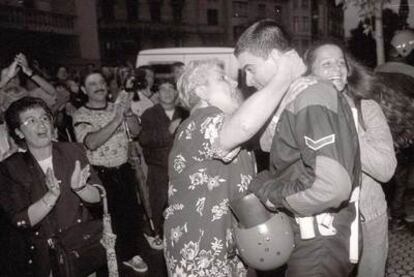The day when masks weren't necessary in San Sebastián
One ertzaina recalls the reaction after Miguel Ángel Blanco's murder, in 1997
"There were six of us, six ertzainas [Basque police officers], among maybe 40,000 or 50,000 people. We told them that we weren't going to do anything to them. They were the good guys," recalls an officer, who has over 18 years under his belt in the Ertzaintza, the Basque regional police force. He prefers to keep his identity anonymous - an identity that was forged by fire in the San Sebastián of the 1990s.
He was one of the police officers who impulsively decided to remove the normally de rigueur mask worn by the Basque police force to protect their identity. That night, the officers stripped off their masks, revealing their faces to the thousands of people protesting in the streets against ETA after the assassination of Miguel Ángel Blanco, a local town councilor for Ermua, on 12 July, 1997.
It is now 500 days since Basque terrorist group ETA claimed its last victim
The six ertzainas had been tasked with defending the headquarters of the now-outlawed nationalist political party Herri Batasuna that night against the advancing tide of protesters. In Ermua, Blanco's birthplace, the same scenes were repeated. All in all, it is estimated that nearly four million people took to the streets throughout Spain in protest between the weekend that ETA kidnapped the young Popular Party councilor and the days following his death.
"We had our masks on, and our helmets, and were carrying rifles. One of my colleagues came up with the idea of taking our masks off," the agent recalls. "He said that he didn't think we had to hide our faces from these people, that it wasn't necessary."
He says he was the last of the six members of the patrol to strip off the protective gear that covered his head that night. Though caution warned him against it, he followed his colleagues' example in the end. As they did so, the protesters rushed to embrace them. "Remember the pictures?" He asks now, saying, "I was the agent that was hugging everybody."
"It is the moment of my professional life that I most cherish. Above all, for the way people were, for the message they were sending out that all of that had to end," says the officer, who after 14 years has decided to speak out. Fate dictated that he would lead the fight against terrorism both while wearing a uniform, and, after ETA murdered one of his family members years later, from the intimacy of his own home.
"They should have isolated ETA politically much sooner," he concludes now. "They would have disbanded, like the First of October Anti-Fascist Resistance groups [GRAPO, an armed group active in Spain in the 1970s and 1980s]."
It is now more than 500 days since ETA claimed its last victim, a French gendarme, on March 16, 2010. The terrorist group has been observing a "permanent, general and verifiable" ceasefire since January 10.








































